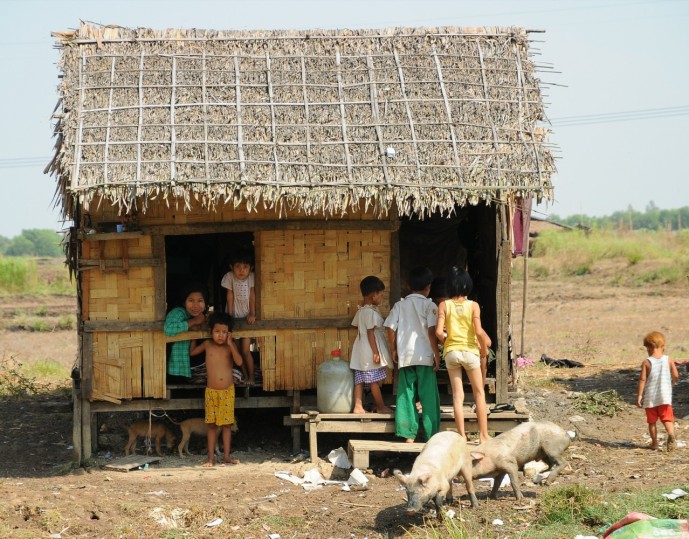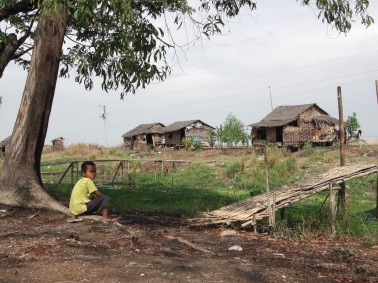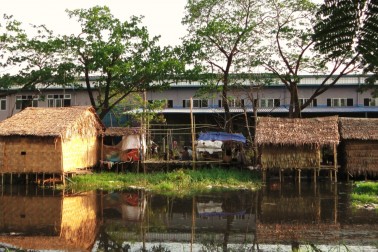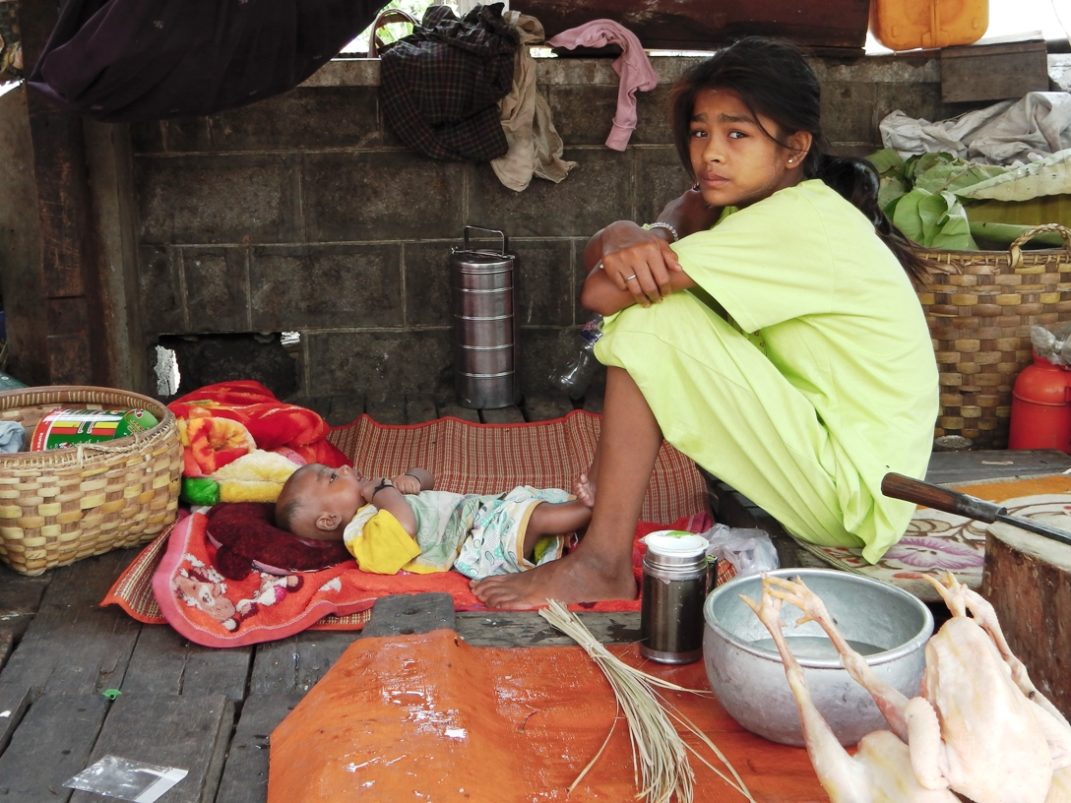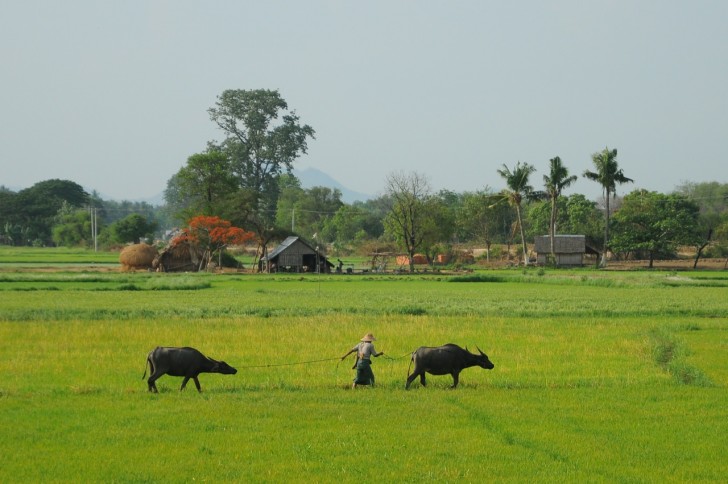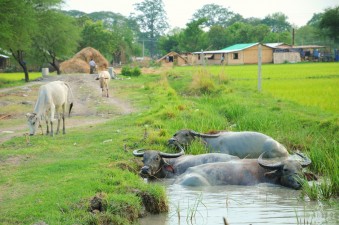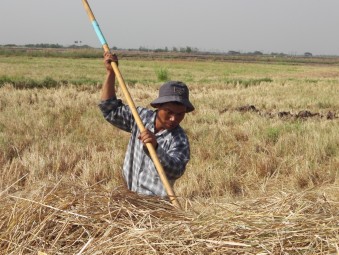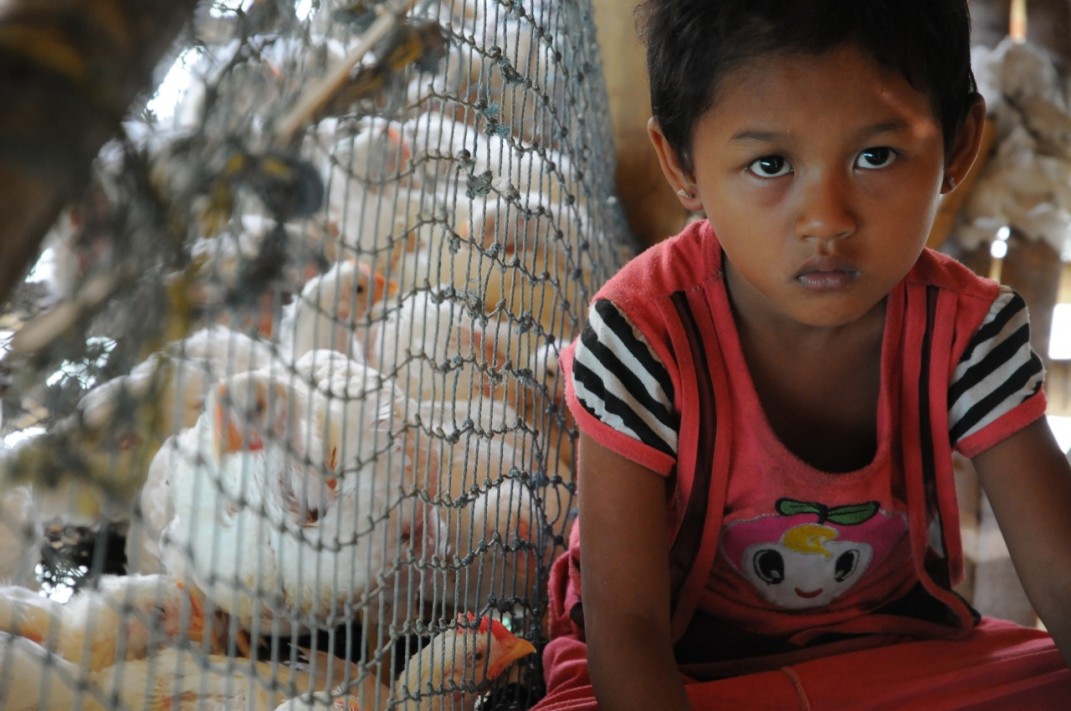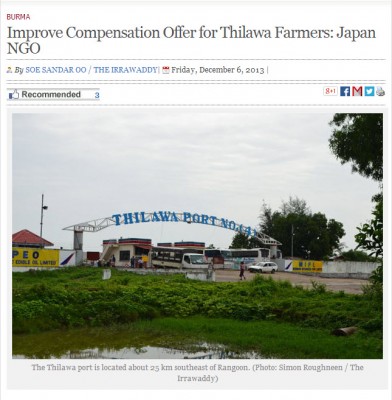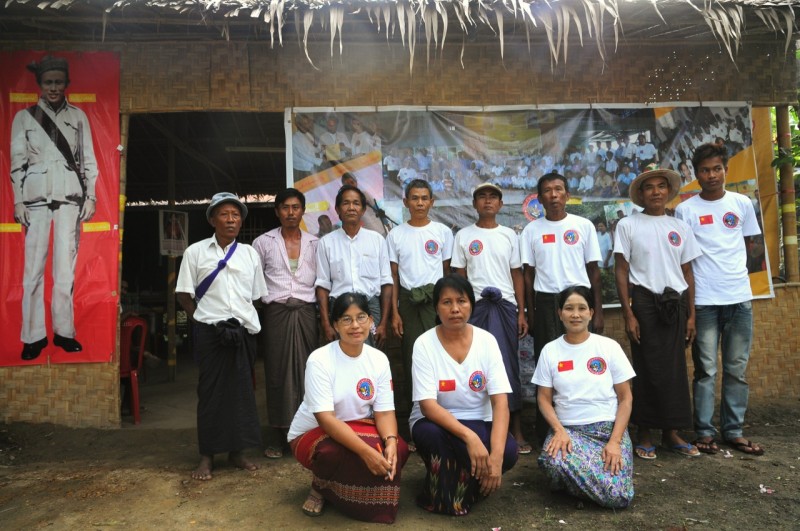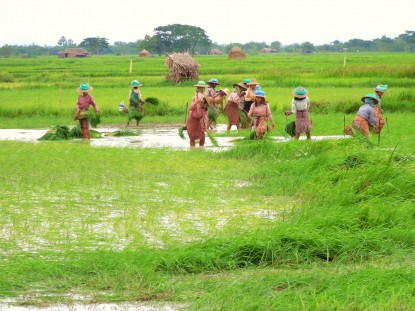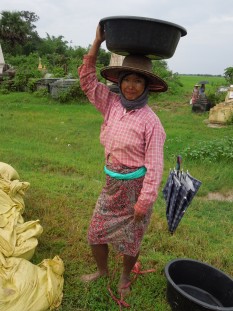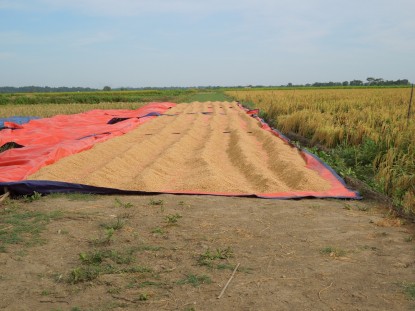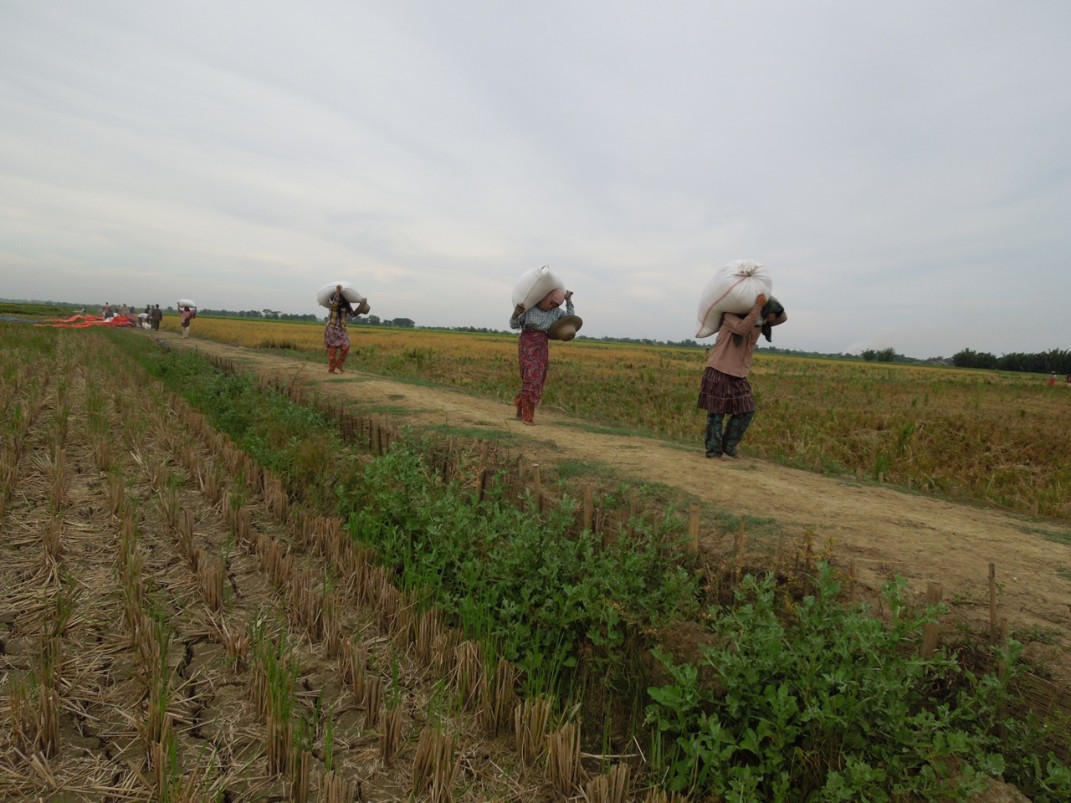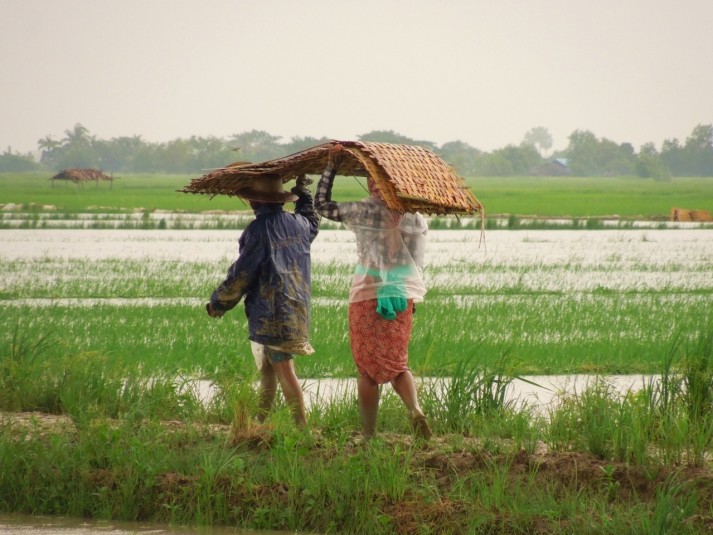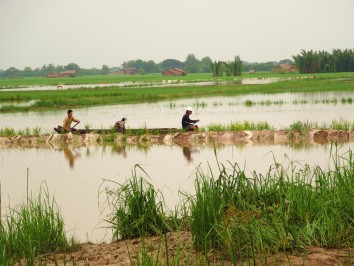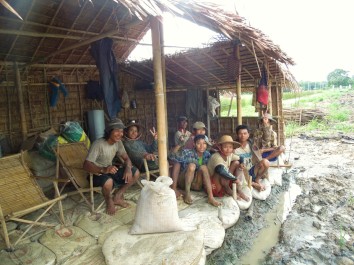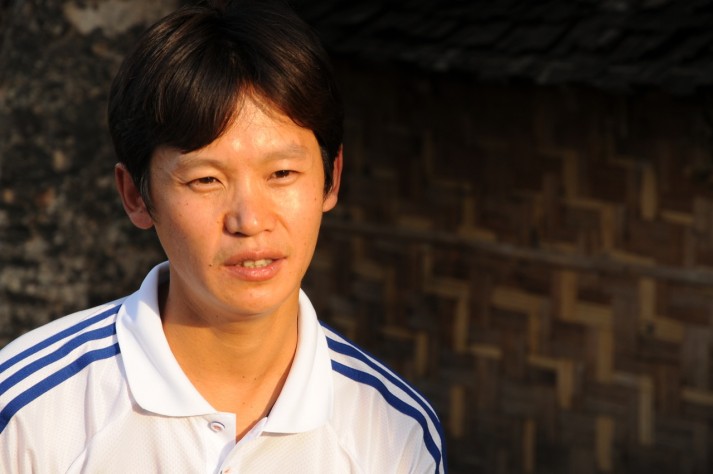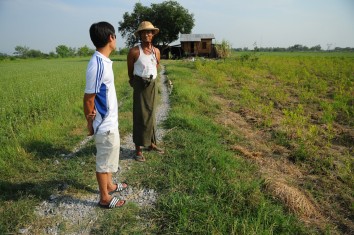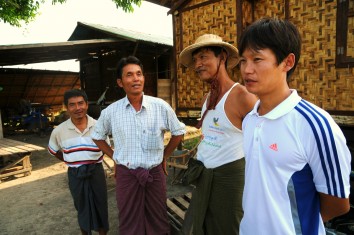文/汪文豪 圖/彭昱融、汪文豪
「緬甸要拚世界上最大的稻米出口國,國內卻有將近四成的農民生活在貧窮線下吃不飽,這不是很矛盾嗎?」緬甸食物安全工作組織(Myanmar Food Security Working Group, FSWG)統籌主任奧瑪博士(Dr. Ohmar Khaing),談到緬甸農業該何去何從時,對當前緬甸政府矛盾的政策,提出批評。
走出極權體制未久的緬甸,自2012年開始經濟快速成長。根據亞洲開發銀行的估計,至今年三月底為止,緬甸的經濟成長率將可達到7.5%,是世界上少數經濟動能被看好的國家。其中世界銀行或是亞洲開發銀行,都建議緬甸提升農業競爭力,擴大稻米出口量,以維持現階段經濟高度成長。
除了國際組織看好緬甸的農業發展潛能,包括中國、美國、歐盟、日本與韓國等經濟大國也積極與緬甸洽簽經濟合作,尤其今年緬甸擔任東南亞國協聯盟輪值主席,再加上戰略地理位處中國進入印度洋的門戶,美、日為圍堵中國,更積極拉攏緬甸。
除了中國長期金援緬甸,投資開發緬甸水利、能源與礦產之外,去年日本首相安倍晉三(あべ しんぞう)親自率領經貿訪問團造訪緬甸,除免除緬甸積欠的債務,還承諾協助開發仰光附近的迪拉瓦經濟區(Thilawa Special Economic Zone),提供緬甸發展農村與教育所需的經費,並恢復中斷將近四十年的緬甸稻米進口。根據計算,相關的債務免除與援助,合計金額高達相當700億新台幣。
對緬甸農民來說,外來投資與經濟援助,美其名是提供就業機會與改善生活水準,背後卻也伴隨著國內權勢人士結合外資,對土地巧取豪奪,擴大貧富差距。增產稻米擴張出口,經濟成長的果實,一般農民未必感受得到,還可能淪入越種越窮的處境。
昔日的稻米出口王國
很難想像1960年代以前,緬甸曾是世界上最大的稻米出口國,因為軍政府極權統治受到國際經濟制裁,緬甸長期陷入孤立,不但耕作與加工技術停留在二次大戰的水準,經過五十年,出口量遠遠落後泰國、越南,甚至柬埔寨。
Dr. U Myint 著作的《緬甸,脫貧之路》(Reducing Poverty in Myanmar: The Way Forward)一書提到,在2008/09年之際,緬甸的稻米產量約為3,580萬公噸,但出口只有100萬公噸;同時間泰國稻米產量約為3,500萬公噸,但出口量可高達870萬公噸。
根據世界銀行的資料,拜開放市場與解除出口管制之賜,2012/13年緬甸稻米出口量創下48年來的新高,卻也只有130萬噸;而2013/14年的出口量,卻仍維持同樣的水準。這表示緬甸農業有結構性的問題,導致產量增幅有限。
另外,根據緬甸稻米公會(Myanmar Rice Federation)的資料,緬甸稻米出口量介於170萬公噸到220萬公噸,出口的方式是海運與邊境貿易。即使這樣的數據遠高於世界銀行的資料,但仍遠低於泰國稻米的出口。這凸顯緬甸的稻作生產面臨結構上的問題,以致增產遇到瓶頸。
亞洲開發銀行歸納,緬甸稻作產業的發展遇到以下的挑戰:一、農產品價格偏低;二、農業資材價格偏高,例如肥料;三、政府對於交通建設,例如公路與橋樑的投資不足;四、農民欠缺信用貸款管道;五、灌溉設施不足;六、農民對農地只有耕作權、沒有所有權;七、交易制度不透明;八、農業研究不發達,農民培訓與推廣服務不足;九、農村缺乏穩定電力供應;十、通貨膨脹。
如果把亞銀所提的這十項挑戰再濃縮,可以總結為:(1)農地爭議;(2)農民的農耕與加工技術有待提升;(3)農村的基礎建設不足。
緬甸的農地悲歌
今年四月初,有超過一百位農民聚集在緬甸最大反對黨「全國人民聯盟」總書記翁山蘇姬(Aung San Suu Kyi)的住所外尋求協助。這些農民是因為緬甸政府為發展迪拉瓦經濟特區(Thilawa Special Economic Zone),土地遭到徵收。
農民會找翁山蘇姬,除了因為她是諾貝爾和平獎得主,更因為她目前擔任緬甸國會議員,是國會的「法治與和諧委員會(Rule of Law, Peace and Stability Committee)」主席,更是緬甸未來看好的總統人選。
這些農民指稱,2003年他們在軍政府極權統治下被迫遷移,土地被拍賣給一家開發公司,該開發公司給予農民的補償金額非常低,農民深感不公平,要求該開發公司提高補償金額,不過該公司拒絕與農民協商。
抗爭農民無奈表示,他們曾經試圖採取任何正規法律途徑尋求救濟,但聲音都遭到漠視,政府不聞不問,受害農民只好採取抗爭手段。
不過開發公司也有話說,他們早就付給農民補償金,受到影響的293戶農民當中,只有5戶拒絕領取補償金。他們公司也取得法院判決可以合法執行拆遷。
迪拉瓦經濟特區是緬甸政府為求追求經濟發展所進行的招商計畫,位於仰光近郊,佔地2400公頃左右,海岸線長達20公里。這項計畫由緬日政府合作,第一期先開發400公頃,由日本知名的三菱、住友、丸紅等株式會社負責開發,除了興建工業區對外招商,也將進行造鎮,興建港口、醫院、學校等公共設施,提供就業機會,同時分散仰光市中心過於擁擠的人口。
不過伴隨這項投資開發計畫背後,也是在地農民被迫搬遷的抗爭史。在這400公頃當中,有48戶農家過去在軍政府的政商威逼下被迫接受不合理的補償條件。等到政治開放,農民開始勇於挺身爭取權益,採取法律訴訟或示威抗議等手段。但是在整個國家追求經濟發展的大帽子下,再加上緬甸政治情勢詭譎,這群農民求助無門。
即使農民寄望翁山蘇姬─這位2015年很可能問鼎緬甸總統寶座的諾貝爾獎得主,對於農民的訴求卻未置可否,僅應允協助受害農民找尋法律方面的協助。
根據緬甸雜誌《伊洛瓦底》(The Irrawaddy)的報導,迪拉瓦經濟特區開發爭議始自於1990年代,當時軍政府為了開發工業區,可以說是用掠奪的方式徵用農民的土地,農民只領到極少的補償金。後來工業區開發不順,農民才又恢復了耕作。
直到日本政府投入資金與緬甸政府合作,重新開發推動迪拉瓦經濟特區,對農民來說,又重蹈土地掠奪的噩夢。這些被迫遷的農民組成 「迪拉瓦社會發展團體(Thilawa Social Development Group)」爭取權益。
一名被迫遷的稻農表示,他原來耕種的農地面積大約0.6英畝(相當於734.47坪),若按照一英畝補償相當於三萬美元的水準,應該要領取相當於一萬八千美元的補償。但是他們被迫接受政府開出的嚴苛條件:補償六年耕作收入價金的損失,並分配60平方米(相當於18.15坪)的土地。
這位稻農說,實際上他只領取到六年的耕作損失補償2,500美元,移除果樹與作物的補償費800美元,以及配給60平方米(相當於18.15坪)的土地。而原有被強徵用來開發工業區的土地,價格早就被炒作不知道翻了幾十倍。 為了維繫與日本合作的經濟關係,不管是現在的緬甸總統登盛(U Thein Sein),或是掌握在野最大勢力的翁山蘇姬,對於受害農民的抗議,都冷漠以對。
不只日本在緬甸的投資開發案遇到農民抗爭,包括中國與緬甸合作在緬北開發礦場,也因為土地徵收不公與造成環境汙染引發農民抗爭。受害農民尋求翁山蘇姬協助,但她的應對態度被農民認為太過消極,引發這些當初也是她的支持者不滿。 相較於緬甸官方與政治人物曖昧不明的態度,緬日政府合作開發迪拉瓦經濟特區的案子,仍然受到日本國內NGO的聲援關注。
「守望湄公河」 守望緬甸農民
在東京名為「守望湄公河(Mekong Watch)」的日本民間組織認為,緬甸政府與財團徵收迪拉瓦經濟特區預定地而遷移農民的過程,違反日本外務省「國際協力機構(JICA, Japan International Cooperation Agency)」執行對外開發援助時,針對環境與社會問題所制定的指導方針。
「守望湄公河」組織專門監督日本政府在東南亞國家進行的投資案是否為當地帶來負面影響。他們指出,緬日合作開發迪拉瓦經濟特區的過程,無論在金額補償、轉業的職業訓練與安置居民的作為,都無法令人接受。
另位迫遷戶抱怨,緬甸政府當初允諾會建造中繼屋、道路與基礎設施安置他們,並且提供教育、醫療與生活照護二至三年,直到他們在新的地方找到工作與安頓下來。但這些承諾完全沒有做到,他們現在被分配居住生活的地方,沒有乾淨水源,井水充滿了爛泥,只能買瓶裝水過活,十三個孩子都輟學了,因為無法負擔每月相當於30美元的上學交通費。
住在迪拉瓦經濟特區預定開發地2,400公頃的農、漁民將近4,500多人,「守望湄公河」認為,緬方安置第一期開發計畫的受害農民措施就有許多不符合JICA援外的準則,要求JICA未來持續援助緬甸進行新開發計畫時,應該嚴格要求緬甸提供完善的安置計畫才行。
緬甸農民除了面臨經濟區開發與資源掠奪而流失土地的危機,緬甸稻米協會(Myanmar Rice Federation)專員Zaw Ye Tun指出,緬甸的相關土地法制不健全,使得小農無法對自己耕作的農地進行土地登記,以致他們無法抵抗官方與私人財團聯手的土地掠奪。
他說,雖然緬甸農部設有專門的單位處理農地利用、登記與仲裁(Settlement and Land Records Department, SLRD),但處理農地爭議的方式仍不夠公正與透明,使小農無法被公正地對待,農地也因此流失。雖然緬甸政府已制定一系列新的法令要保障農民買賣農地的權利,不過農地爭議事件仍不斷上演。
停留二次大戰水準的農耕技術
除了法令上對於農民的耕作權保障不足,緬甸農民的耕作技術與稻作產業,也因過去軍政府時代的封閉與保守,停滯不前。曾經前往緬甸考察稻作產業的前台灣區稻作協會理事長翁良材說,在台灣,從烘乾稻穀、儲存與碾米,都已經進入電腦控制的一貫化作業,但是緬甸農民烘乾稻穀還普遍停留在「日曬」,甚至連碾米設備還停留在使用蒸汽機的階段。
雖然台灣有少數從事有機農法的小農訴求以「日曬」稻榖為產品特色,不過從稻作產業的角度來說,緬甸農民目前慣用的日曬稻榖,會有乾燥度不均衡,導致碾米時碎粒過多。當白米碎粒過多,在商業市場上只能拿來做為加工米或飼料米,價格偏低,品質也無法與泰國、越南出口稻米競爭。
雖然緬甸適於稻作耕種的面積多達1,240萬公頃,相當於3.44個台灣面積;農民人數占了全國六千萬人口的七成,遠遠是台灣總人口數的兩倍,但緬甸農業仍面臨農村勞動力流失與機械化程度不足的困境。
亞洲開發銀行的資料指出,緬甸有30%的農村人口沒有農地或收入來源,約37%的農戶土地小於兩公頃。這只比台灣農戶平均持有1.1公頃的水準略高一些。由於務農無法維生,許多農民又買不起農機具機械化耕種,許多農戶只好把孩子送到都市打工。
猶如香港到處可見港式飲茶,緬甸主要大城市如仰光、曼德勒或是勃生等地,也隨處可見緬式茶館。走進茶館找張桌子坐下,眼神投往服務生,嘴裡發出「咻咻」的聲音,就立刻會有小孩子來幫你點餐。這些孩子大多介於七至十二、三歲不等,來自農村,因為家裡貧困,年紀小小就被送到茶館賺錢養家。
由於男孩子都被送到城市打工養家,女孩子就成為農村勞動力主要來源,有些家庭實在太窮困養不起,在緬甸的孤兒院裡,女孩子的比例遠遠超過男孩。
由於窮困,緬甸農民就算有農地,無力負擔整地費用,也少有能力買得起農機具。就算勉強有能力買稍微廉價的中國二手農機,一遇到雨季,農田排水不良,整個農地泥濘不堪,耕耘機根本無用武之地。
受投資台商之邀到緬甸發展台灣水稻育苗技術的雲林元長稻農林旭陽觀察,緬甸有非常好的稻作品種,但缺乏像台灣有這麼普及與高素質的農業研發與推廣單位,所以農民缺乏良好的耕作知識與技術。
林旭陽舉例,台灣農田通常只耕種單一品種,避免不同稻種混雜影響耕作品質,不過緬甸農民比較欠缺稻種純化的觀念,有甚麼品種就種甚麼,導致收成時混雜不同品種的水稻,影響品質。又如插秧,緬甸農民插秧時間太晚,分蘗期都快結束才插秧,影響水稻幼穗分化,以致結穗數量未如預期。
林旭陽說,台灣水稻依品種差別,平均每公頃產量達六至十公噸不等,但緬甸水稻田每公頃平均產量只有四、五公噸,有極大的成長改進空間。
緬甸的農村建設與農業管理不足
不若台灣農村有著四通八達的灌溉水道、埤塘與筆直農路,緬甸農村的水田仍處於看天吃飯的情形,不但欠缺水利建設,遇到雨季,農路泥濘顛簸難行。
緬甸氣候主要分為熱季(三至四月)、雨季(五至十月)與涼季(十一月至隔年二月),水稻生產主要依賴雨季降雨。雖然緬甸其他季節也適合種植水稻,但水利灌溉系統不夠齊全與普及,稻米生產還是被迫看天吃飯。 緬甸雨季時的降雨量非常驚人。
林旭陽說,台灣人常說西北雨來得快、去得也快,但在緬甸雨季,說下雨就下雨,雨量多到可把水田淹滿跟路面一樣高,把土堤沖毀。但水利建設不足,這些雨水未能蓄積起來留在其他季節有效使用,因此熱季時整個農田又乾涸難以耕作。
前台灣區稻作協會理事長翁良材說,緬甸氣候條件非常適合稻作生產,如果有好的水利建設,或是作簡易的蓄水設施,要達到一年三穫都沒有問題。可惜緬甸政府對農田水利的建設,投資不足,農民也貧窮,無力將水田整地至適合施用農機具的狀態,實在很可惜。 另外,緬甸電力系統供應不穩定,跳電是家常便飯。若要引進烘乾稻穀、冷藏儲存與碾米的一貫化電腦作業系統,電力將會是一大考驗。
除了農村基礎建設投資不足,緬甸本身欠缺輕工業,化學肥料與農藥的供應依賴從中國進口。由於緬甸政府管控農業資材品質的能力尚不健全,因此有許多中國的偽劣農藥透過邊境貿易進入到緬甸農村,甚至有中國商人冬季到緬甸中部大城曼德勒周邊租用農地種植西瓜回銷大陸,卻把劣質農業資材對環境的負面影響留在緬甸農地上。
「有農民反應收回中國商人種西瓜的農地後,要種水稻或雜糧,竟然種不出來,土地要休養過幾個月之後,才能恢復種植,」嘉義大學園藝系畢業的緬華青年韓楊說道。 1975年次的韓楊來自曼德勒,十八歲就到台灣讀書,自嘉義大學畢業後,曾在台灣許多農場工作,一待就是十八年。緬甸政治改革開放後,三年多前返回緬甸發展。
由於韓楊在台灣所學與所從事的工作都與農業相關,返回緬甸創業後,也從事與園藝相關工作,因此特別關心農業相關事務。當他知道緬甸農民朋友遇過租地給中國商人種西瓜的下場後,不禁想起台灣之前曾查獲從中國走私的偽劣農藥新聞,曾鬧得沸沸揚揚。
「後來我很多緬甸農民朋友再也不敢把農地租給中國商人種西瓜了,因為不知道用了甚麼化學農藥或肥料,對土地傷害這麼大,」韓楊說。
昔日的稻米王國,要如何重新擦亮農業的金字招牌?農民要如何在國家重振農業的過程受惠?對緬甸來說,雖然挑戰重重,但可以不必摸著石頭過河,因為同為小農經濟的台灣農業發展經驗,或許有機會助緬甸農業與農民一臂之力。

